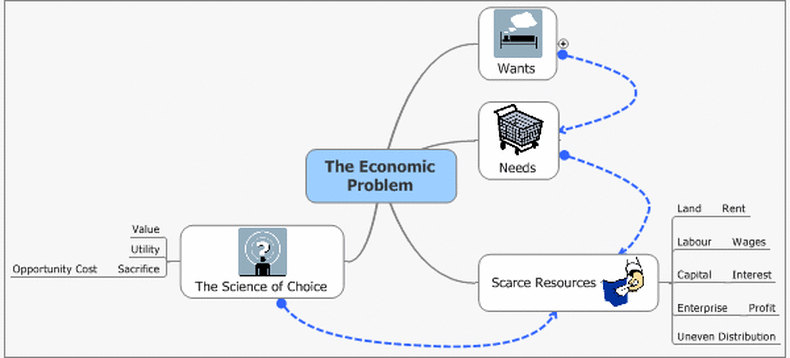What we will study?

By the end of this unit you should be able to:
- Define the nature of the economic problem
- Define the factors of production (land, labour, capital and enterprise)
- Understand and explain opportunity cost
- Understand and be able to use production possibility curves
Unit I: The Economic Problem:
Resources are scarce whilst human wants are unlimited

This is the reason for the existence of this subject. In reality most resources are scarce. Similarly individuals and nations have unlimited wants.
The Basics
Scare Resources
There are only a limited number of resources such as workers, machines, factories, raw materials etc. Yet there are a number of different ways in which they could be used.
Similarly people only have a limited amount of money. Yet they have lots of needs and wants to satisfy.
Also the Government has a limited amount of money so therefore it is unable to satisfy all its wants.
THE BASIC ECONOMIC PROBLEM – the problem arises because resources are scarce, but human wants are unlimited.
KEY QUESTION
What is the difference between needs and wants?
The Basics
Scare Resources
There are only a limited number of resources such as workers, machines, factories, raw materials etc. Yet there are a number of different ways in which they could be used.
Similarly people only have a limited amount of money. Yet they have lots of needs and wants to satisfy.
Also the Government has a limited amount of money so therefore it is unable to satisfy all its wants.
THE BASIC ECONOMIC PROBLEM – the problem arises because resources are scarce, but human wants are unlimited.
KEY QUESTION
What is the difference between needs and wants?
Unit 1 Plan - Basic Economic Ideas
| Unit 1 Plan Printable Version |
Opportunity Cost
In 1936 the German Nazi leader Hermann Goering said “We have no
butter…but I ask you, would you rather have butter or guns…preparedness makes us powerful. Butter merely makes us fat.” The important word of course is or. Goering suggests that Germany has a choice – guns or butter. Economic choice - is deciding between different uses of scarce resources Opportunity cost - is the benefit that is lost in making a choice between two competing uses of scarce resources. It is the next best alternative |
|
Examples of Opportunity Cost
Allocation of Resources This is about how resources are allocated between competing uses Examples * Coca Cola decide to spend $50 billion on advertising * The government decides to spend $100 billion on hospitals * An individual allocates their time to study rather than playing football |
ACTION
1. Think of an opportunity cost that you have experienced recently
a) with money
b) with your time
2. What could be an opportunity cost of you staying up late studying for a test?
Answer: The next day you will feel tired and sleepy so therefore your opportunity cost is a good nights sleep.
Click the following link to watch an excellent video that explains opportunity cost with many examples.
1. Think of an opportunity cost that you have experienced recently
a) with money
b) with your time
2. What could be an opportunity cost of you staying up late studying for a test?
Answer: The next day you will feel tired and sleepy so therefore your opportunity cost is a good nights sleep.
Click the following link to watch an excellent video that explains opportunity cost with many examples.
The Law of Increasing Opportunity Cost
|
Why does the PPC bow outwards?
The production possibility curve (PPC) is a model showing how resources can be used to produce two different goods or services. In the video on the left we have Pizzas and Cars. The graph is bowed outwards due to a basic concept used in economics - the principle of increasing opportunity cost. If a producer were to produce more of one good or service, the scarcity of resources dictates that it is impossible to maintain the previous amount of production of the other good or service. If more of one good or service is produced, the opportunity cost of the reduction of the other good or service increases, therefore the gradient of the curve increases. In this case it would mean that resources such as farmers are now working in car factories and obviously they arent going to be as productive as skilled car factory workers because they are more suited to making pizzas. |
|
Sample Classroom Activities
Here you can download worksheet, PowerPoints and other documents that we have used in class during this unit.
|
|
| ||||||
Opportunity Cost Assignment
For the following assignment you will imagine you are an economic advisor to the President of the United States. Download the following file for instructions.
| Opportunity Cost Assignment |
Milton Friedman
Friedman summarizes his argument for the free market system over the command economy.
Review Materials
Attached below is a copy of the presentation we have been using in class for this unit along with further explainations of the price mechanism and basic economic systems.
|
|
| ||||||
| Unit 1 Test Answers |


